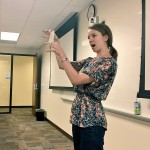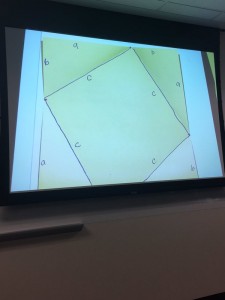Over the last several years, I’ve been able to work with teachers from local  school districts as part of a grant-funded project called “The Math and Science Partnership Program” (MSP). Phase II of this program focuses on “Improving Math & Science Teaching through School Outreach.” We offer free professional development workshops for teachers, held on Saturdays, several times a year. Teachers who are part of our MSP Partner Schools can earn a $150 stipend from attending each workshop. All workshops are accepted for re-certification credit in the Berkeley & Charleston County School districts. Descriptions of our workshops dating back to 2014 are available online.
school districts as part of a grant-funded project called “The Math and Science Partnership Program” (MSP). Phase II of this program focuses on “Improving Math & Science Teaching through School Outreach.” We offer free professional development workshops for teachers, held on Saturdays, several times a year. Teachers who are part of our MSP Partner Schools can earn a $150 stipend from attending each workshop. All workshops are accepted for re-certification credit in the Berkeley & Charleston County School districts. Descriptions of our workshops dating back to 2014 are available online.
Last weekend, together with my co-Leader Christel Wohlafka, I held a Workshop called “Mathematical Fun with Paper Folding.” I was inspired to create this workshop as a direct result of Patrick Honner‘s “Scalene Triangle One-Cut Challenge,” which I think I learned about because of a mention of it by Evelyn Lamb. The “scalene triangle” puzzle stuck with me for several hours one day and I was almost unable to function in any capacity until I figured it out.

Christel Wohlafka College of Charleston Department of Mathematics
Our agenda for our “Paper Folding Workshop” is available online. Many of our activities were inspired by great things I’ve learned about on Twitter, and many are available online at their original sources:
- The “Scalene Triangle” puzzle is part of @MrHonner’s blog series, “Fun with Folding”: http://mrhonner.com/fun-with-folding. The “One Cut Challenge” activities came from his “Fun with One Cut!” Workshop that he gave at the 2013 TIME conference. He blogged about it here: http://mrhonner.com/archives/11863 His templates are available online as a PDF file here: http://mrhonner.com/wp-content/uploads/2014/01/TIME-2000-2013-Templates.pdf

- “Hole punch symmetry” was produced by Joel Hamkins (@JDHamkins). He wrote about it in a recent blog post: http://jdh.hamkins.org/math-for-nine-year-olds-fold-punch-cut/ The template itself is available online: https://drive.google.com/file/d/0Bw3BMDqKsMmXRXlXU2xqbXlFYms/view Joel has a whole set of blog posts devoted to “Math for Kids” — http://jdh.hamkins.org/category/math-for-kids/
- The “Fold & Cut Theorem – Numberphile” YouTube Video we watched is available here: https://www.youtube.com/watch?v=ZREp1mAPKTM The female mathematician featured in the video is Katie Steckles, who finished her Math Ph.D. in 2011 at the University of Manchester. Katie’s webpage: http://www.katiesteckles.co.uk/ or you can find her on Twitter: @stecks
- Christel’s handout on “Dividing a Square into Thirds” came from an activity on Illustrative Mathematics
- Christel’s handout on “Paper Folding Proof of the Pythagorean Theorem” came from this “Teachers of India” resource.

I had a lot of fun at this Workshop and I hope we will offer it again next academic year. Between now and then, I need to order more and better-quality hole-punchers. With some of Joel’s “One Punch” activities, the paper ends up folded over itself five or six times, and some of the “well-loved” hole punchers we had with us weren’t up to the task.


